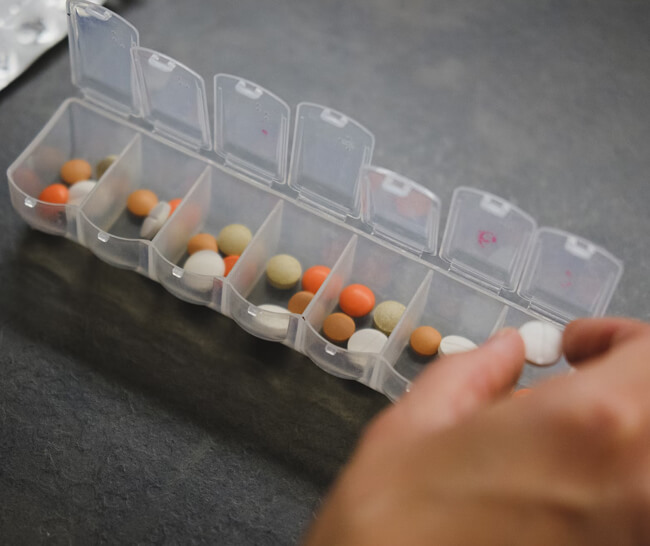Type 2 diabetes is a health condition where the body can’t control or use glucose (sugar) for energy. It occurs when the body either doesn’t make enough insulin, the hormone made by the pancreas to lower blood sugar, or the cells become resistant, and blood sugar remains high.
According to the American Diabetes Association, 1.2 million people are diagnosed with type 2 diabetes every year in the U.S. While a higher percentage of diagnosed cases are in men, the Centers for Disease Control reports that more women live undiagnosed with diabetes than men. Men and women share many of the same symptoms, but women may experience specific symptoms that may be overlooked or chalked up to other issues.
If left untreated, diabetes risks are serious, but early diagnosis and proper management can make a huge difference in remaining healthy and preventing complications.
In this article, you’ll learn about the signs of type 2 diabetes in women and what steps to take if you suspect you or a loved one may have this condition.
{{mid-cta}}
Type 2 Diabetes in Women: Risk Factors
Several risk factors can contribute to the development of type 2 diabetes in women. Risk factors are typically divided into two categories: things you can change or have control over and those you can’t change.
- Non-modifiable risk factors are those that you don’t necessarily have control over. For example, middle-aged and elderly adults have an increased risk of developing diabetes compared to younger people.
Other non-modifiable risk factors include family history, race, and ethnicity. Women with a family history of type 2 diabetes are more likely to develop the disease themselves. Additionally, African American, Hispanic/Latina, Native American, Pacific Islander, and Asian American women are also at a higher risk for developing type 2 diabetes.4
- Modifiable risk factors are those that you can control or change. Being overweight or obese is considered a modifiable risk factor for type 2 diabetes. While not everyone in a larger body will develop the disease, excess weight is a known contributing factor. Other medical conditions like high blood pressure and high cholesterol, or even a lack of physical activity, may also increase the risk of developing type 2 diabetes. 4
There are a few risk factors that are specific to women, including having a history of gestational diabetes and the type of diabetes that occurs during pregnancy. If a woman has had gestational diabetes or gives birth to a baby weighing more than 9 pounds, she is at an increased risk for developing type 2 diabetes later in life.
Additionally, polycystic ovary syndrome (PCOS), a condition characterized by hormone imbalances and insulin resistance, can also increase a woman's risk for developing type 2 diabetes.
10 Type 2 Diabetes Symptoms Men and Women Share

Women and men share many of the same type 2 diabetes symptoms. These symptoms primarily stem from the inflammatory effects of high blood sugar levels on the body. Blood sugar can be high, or someone may have prediabetes for years before symptoms show up, but if you notice any of these early signs of diabetes, it’s essential to make an appointment with your doctor:
- Frequent urination
- Increased hunger and thirst
- Skin discoloration, especially around the neck, groin, and armpits
- Cuts and skin infections that won’t heal
- Unexplained weight loss or weight gain
- Fatigue
- Blurry vision
- Tingling or numbness in feet and toes
- Dry skin
- Illness or infections occurring more often
<p class="pro-tip"><strong>Also Read: </strong><a href="foods-to-avoid-with-type-2-diabetes">Foods to Avoid with Type 2 Diabetes: A Comprehensive Deep Dive</a>.</p>
7 Signs and Symptoms of Type 2 Diabetes in Women
In addition to the symptoms above, women may experience additional signs and symptoms of type 2 diabetes. Because they aren't specific to diabetes, it may not be immediately apparent to connect them with the disease. Some of these signs and symptoms include:
- Frequent Yeast Infections: High blood sugar levels can create an environment prime for yeast growth, leading to more frequent infections
- Pain During Sex: Related to yeast infections, high blood sugar levels can also cause vaginal dryness and discomfort during intercourse
- Decreased Sex Drive: High blood sugar can damage capillaries and inhibit blood flow, including in the genitals, causing problems with lubrication and nerve response, making it difficult to achieve orgasm
- Urinary Tract Infections (UTI): UTIs are common in women with diabetes due to higher levels of sugar in the urine, which can encourage bacterial growth
- Irregular Cycles: Inflammation, insulin resistance, and high blood sugar may all impact sex hormones and lead to heavier or irregular periods
- Difficulty Becoming Pregnant: Blood sugar and insulin resistance can impact sex hormones and may make it harder to conceive
- Post-menopausal Weight Gain: It's not the only factor, but insulin resistance and high blood sugar can make it more challenging to maintain a healthy weight after menopause
Potential Risks of Untreated Type 2 Diabetes in Women
When untreated, consistently high blood sugar stemming from type 2 diabetes can lead to serious health risks due to the inflammation and damage to blood vessels from elevated glucose levels. Women with untreated type 2 diabetes are at an increased risk for the following conditions.
- Heart Attack and Stroke: Type 2 diabetes raises the risk of heart disease due to damage to blood vessels and increased inflammation. One study found that women with diabetes (including type 1 diabetes and type 2 diabetes) were more at risk of heart failure than men with diabetes
- Kidney Disease: High blood sugar levels can damage the small blood vessels in the kidneys, leading to chronic kidney disease
- Eye Problems: Diabetes complications can damage the blood vessels in the eyes, leading to blurred vision, vision loss, or even blindness
- Nerve Damage (Neuropathy): Prolonged high blood sugar can cause nerve damage, leading to tingling, numbness, and pain in the hands and feet. Nerve damage can also affect other parts of the body, including the digestive system, causing problems with digestion and bowel movements
- Infertility or Pregnancy Complications: Uncontrolled diabetes can lead to fertility issues in women, making it more difficult to conceive. Women with type 2 diabetes who aren’t properly followed by an OB-GYN also have an increased risk of complications during pregnancy
Managing Type 2 Diabetes

Diagnosis and finding the right care team are the first steps to managing type 2 diabetes. Once you have a diagnosis, you can take steps to control your blood sugar levels and reduce your risk of developing complications. There isn’t a cure for diabetes, but many people successfully manage and reverse their symptoms through lifestyle changes and medication.
Medications for type 2 diabetes work in different ways to help manage the condition. They can enhance glucose utilization, boost insulin production, or provide insulin directly. Some people can wean down on medicine when lifestyle changes take effect, while others may require long-term medication management.
Lifestyle changes are essential with or without medication and are considered a first-line treatment. Exercise and weight management are key components to controlling type 2 diabetes. Regular physical activity can help improve insulin sensitivity by making the cells more responsive to lower blood sugar.
Nutrition also plays a crucial role, as food directly affects your blood sugar levels. The right amount of carbohydrates paired with protein and fiber can help minimize blood sugar spikes. A dietitian or other certified diabetes educator (CDE) can help create an individualized nutrition plan, as every person responds differently to different foods.
Alternative medicine can also be used alongside traditional treatment methods for type 2 diabetes. Some examples include acupuncture, supplements like magnesium or chromium, and meditation to support stress levels. However, it's essential to consult with your healthcare provider when trying any alternative treatments (especially supplements) to make sure they won't interfere with your medications or have unwanted side effects.
Learn More About How to Improve Blood Sugar Health With Signos’ Expert Advice
Pairing Signos' real-time feedback with continuous glucose monitor (CGM) readings can effectively support healthy blood sugar for anyone with or without diabetes. With personalized guidance, women with type 2 diabetes can track their progress and make informed decisions about their diet, exercise, and stress levels with their healthcare team.
You can learn more about the impact of glucose on your health on the Signos blog or find out if Signos is a good fit for you by taking a quick quiz.
<p class="pro-tip"><strong>Learn More: </strong><a href="diabetic-stroke">Diabetes and Stroke: Risks, Symptoms, Treatments, and Key Insights</a>.</p>
- Item 1
- Item 2
- item 3
Topics discussed in this article:
References
- American Diabetes Association. (n.d.). About Diabetes. Retrieved from https://www.diabetes.org/about-diabetes/statistics/about-diabetes
- Centers for Disease Control and Prevention. (n.d.). National Diabetes Statistics Report. Retrieved from https://www.cdc.gov/diabetes/data/statistics-report/index.html
- Yan, Z., Cai, M., Han, X., Chen, Q., & Lu, H. (2023). The Interaction Between Age and Risk Factors for Diabetes and Prediabetes: A Community-Based Cross-Sectional Study. Diabetes, metabolic syndrome and obesity : targets and therapy, 16, 85–93. https://doi.org/10.2147/DMSO.S390857
- Ismail, L., Materwala, H., & Al Kaabi, J. (2021). Association of risk factors with type 2 diabetes: A systematic review. Computational and structural biotechnology journal, 19, 1759–1785. https://doi.org/10.1016/j.csbj.2021.03.003
- Livadas, S., Anagnostis, P., Bosdou, J. K., Bantouna, D., & Paparodis, R. (2022). Polycystic ovary syndrome and type 2 diabetes mellitus: A state-of-the-art review. World journal of diabetes, 13(1), 5–26. https://doi.org/10.4239/wjd.v13.i1.5
- Centers for Disease Control and Prevention. (n.d.). Symptoms of Diabetes. Retrieved from https://www.cdc.gov/diabetes/basics/symptoms.html
- Mohammed, L., Jha, G., Malasevskaia, I., Goud, H. K., & Hassan, A. (2021). The Interplay Between Sugar and Yeast Infections: Do Diabetics Have a Greater Predisposition to Develop Oral and Vulvovaginal Candidiasis?. Cureus, 13(2), e13407. https://doi.org/10.7759/cureus.13407
- Di Stasi, V., Maseroli, E., & Vignozzi, L. (2022). Female Sexual Dysfunction in Diabetes: Mechanisms, Diagnosis and Treatment. Current diabetes reviews, 18(1), e171121198002. https://doi.org/10.2174/1573399818666211117123802
- Ahmed, A. E., Abdelkarim, S., Zenida, M., Baiti, M. A. H., Alhazmi, A. A. Y., Alfaifi, B. A. H., Majrabi, R. Q. M., Khormi, N. Q. M., Hakami, A. A. A., Alqaari, R. A. M., Alhasani, R. A., Alajam, R. A., Alshehri, M. M., Alenazi, A. M., Alqahtani, B., Alshamrani, M., Alhowimel, A., & Abdelwahab, S. I. (2023). Prevalence and Associated Risk Factors of Urinary Tract Infection among Diabetic Patients: A Cross-Sectional Study. Healthcare (Basel, Switzerland), 11(6), 861. https://doi.org/10.3390/healthcare11060861
- Yeung, E. H., Zhang, C., Mumford, S. L., Ye, A., Trevisan, M., Chen, L., Browne, R. W., Wactawski-Wende, J., & Schisterman, E. F. (2010). Longitudinal study of insulin resistance and sex hormones over the menstrual cycle: the BioCycle Study. The Journal of clinical endocrinology and metabolism, 95(12), 5435–5442. https://doi.org/10.1210/jc.2010-0702
- Mattsson, K., Nilsson-Condori, E., Elmerstig, E., Vassard, D., Schmidt, L., Ziebe, S., & Jöud, A. (2021). Fertility outcomes in women with pre-existing type 2 diabetes-a prospective cohort study. Fertility and sterility, 116(2), 505–513. https://doi.org/10.1016/j.fertnstert.2021.02.009
- Chadalavada, S., Jensen, M. T., Aung, N., Cooper, J., Lekadir, K., Munroe, P. B., & Petersen, S. E. (2021). Women With Diabetes Are at Increased Relative Risk of Heart Failure Compared to Men: Insights From UK Biobank. Frontiers in cardiovascular medicine, 8, 658726. https://doi.org/10.3389/fcvm.2021.658726
- Jitraknatee, J., Ruengorn, C., & Nochaiwong, S. (2020). Prevalence and Risk Factors of Chronic Kidney Disease among Type 2 Diabetes Patients: A Cross-Sectional Study in Primary Care Practice. Scientific reports, 10(1), 6205. https://doi.org/10.1038/s41598-020-63443-4
- Lundeen, E. A., Burke-Conte, Z., Rein, D. B., Wittenborn, J. S., Saaddine, J., Lee, A. Y., & Flaxman, A. D. (2023). Prevalence of Diabetic Retinopathy in the US in 2021. JAMA ophthalmology, 141(8), 747–754. https://doi.org/10.1001/jamaophthalmol.2023.2289
- Feldman, E. L., Callaghan, B. C., Pop-Busui, R., Zochodne, D. W., Wright, D. E., Bennett, D. L., Bril, V., Russell, J. W., & Viswanathan, V. (2019). Diabetic neuropathy. Nature reviews. Disease primers, 5(1), 42. https://doi.org/10.1038/s41572-019-0097-9
- Bapayeva, G., Terzic, S., Dotlic, J., Togyzbayeva, K., Bugibaeva, U., Mustafinova, M., Alisheva, A., Garzon, S., Terzic, M., & Laganà, A. S. (2022). Pregnancy outcomes in women with diabetes mellitus - the impact of diabetes type and treatment. Przeglad menopauzalny = Menopause review, 21(1), 37–46. https://doi.org/10.5114/pm.2022.113781
- Celli, A., Barnouin, Y., Jiang, B., Blevins, D., Colleluori, G., Mediwala, S., Armamento-Villareal, R., Qualls, C., & Villareal, D. T. (2022). Lifestyle Intervention Strategy to Treat Diabetes in Older Adults: A Randomized Controlled Trial. Diabetes care, 45(9), 1943–1952. https://doi.org/10.2337/dc22-0338
- Setiyorini, E., Qomaruddin, M. B., Wibisono, S., Juwariah, T., Setyowati, A., Wulandari, N. A., Sari, Y. K., & Sari, L. T. (2022). Complementary and alternative medicine for glycemic control of diabetes mellitus: A systematic review. Journal of public health research, 11(3), 22799036221106582. https://doi.org/10.1177/22799036221106582
































